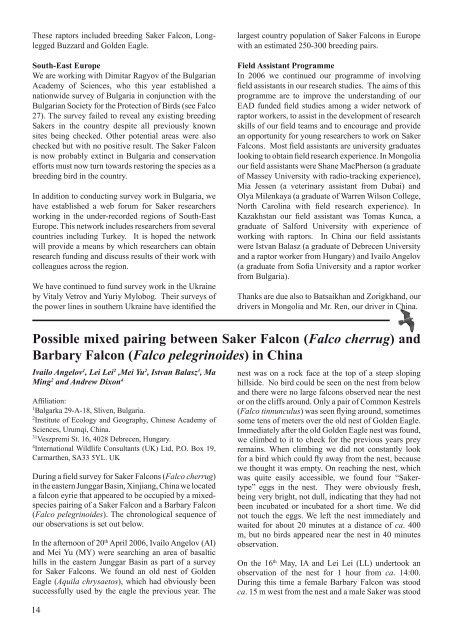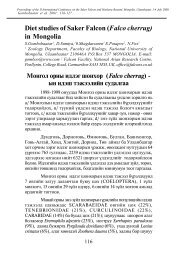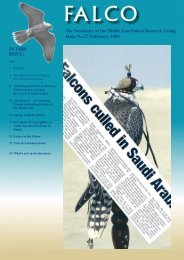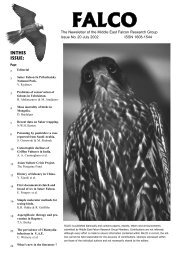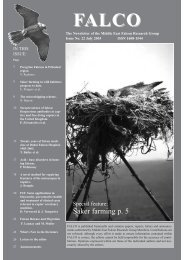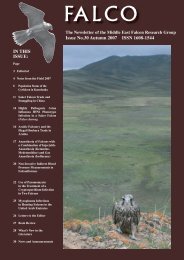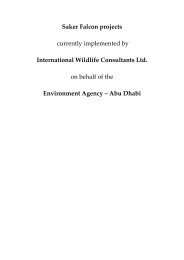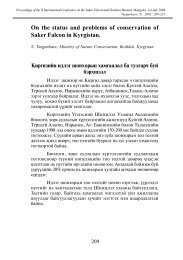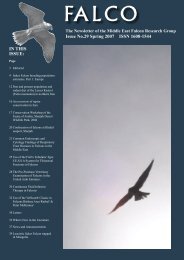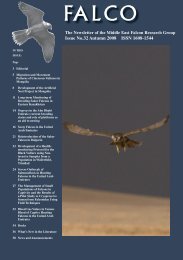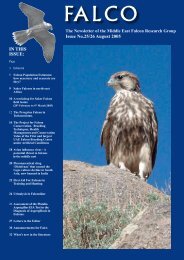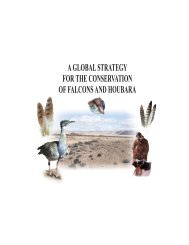Falco 28 - International Wildlife Consultants Ltd.
Falco 28 - International Wildlife Consultants Ltd.
Falco 28 - International Wildlife Consultants Ltd.
You also want an ePaper? Increase the reach of your titles
YUMPU automatically turns print PDFs into web optimized ePapers that Google loves.
These raptors included breeding Saker <strong>Falco</strong>n, Longlegged<br />
Buzzard and Golden Eagle.<br />
South-East Europe<br />
We are working with Dimitar Ragyov of the Bulgarian<br />
Academy of Sciences, who this year established a<br />
nationwide survey of Bulgaria in conjunction with the<br />
Bulgarian Society for the Protection of Birds (see <strong>Falco</strong><br />
27). The survey failed to reveal any existing breeding<br />
Sakers in the country despite all previously known<br />
sites being checked. Other potential areas were also<br />
checked but with no positive result. The Saker <strong>Falco</strong>n<br />
is now probably extinct in Bulgaria and conservation<br />
efforts must now turn towards restoring the species as a<br />
breeding bird in the country.<br />
In addition to conducting survey work in Bulgaria, we<br />
have established a web forum for Saker researchers<br />
working in the under-recorded regions of South-East<br />
Europe. This network includes researchers from several<br />
countries including Turkey. It is hoped the network<br />
will provide a means by which researchers can obtain<br />
research funding and discuss results of their work with<br />
colleagues across the region.<br />
We have continued to fund survey work in the Ukraine<br />
by Vitaly Vetrov and Yuriy Mylobog. Their surveys of<br />
the power lines in southern Ukraine have identified the<br />
largest country population of Saker <strong>Falco</strong>ns in Europe<br />
with an estimated 250-300 breeding pairs.<br />
Field Assistant Programme<br />
In 2006 we continued our programme of involving<br />
field assistants in our research studies. The aims of this<br />
programme are to improve the understanding of our<br />
EAD funded field studies among a wider network of<br />
raptor workers, to assist in the development of research<br />
skills of our field teams and to encourage and provide<br />
an opportunity for young researchers to work on Saker<br />
<strong>Falco</strong>ns. Most field assistants are university graduates<br />
looking to obtain field research experience. In Mongolia<br />
our field assistants were Shane MacPherson (a graduate<br />
of Massey University with radio-tracking experience),<br />
Mia Jessen (a veterinary assistant from Dubai) and<br />
Olya Milenkaya (a graduate of Warren Wilson College,<br />
North Carolina with field research experience). In<br />
Kazakhstan our field assistant was Tomas Kunca, a<br />
graduate of Salford University with experience of<br />
working with raptors. In China our field assistants<br />
were Istvan Balasz (a graduate of Debrecen University<br />
and a raptor worker from Hungary) and Ivailo Angelov<br />
(a graduate from Sofia University and a raptor worker<br />
from Bulgaria).<br />
Thanks are due also to Batsaikhan and Zorigkhand, our<br />
drivers in Mongolia and Mr. Ren, our driver in China.<br />
Possible mixed pairing between Saker <strong>Falco</strong>n (<strong>Falco</strong> cherrug) and<br />
Barbary <strong>Falco</strong>n (<strong>Falco</strong> pelegrinoides) in China<br />
Ivailo Angelov 1 , Lei Lei 2 ,Mei Yu 2 , Istvan Balasz 3 , Ma<br />
Ming 2 and Andrew Dixon 4<br />
Affiliation:<br />
1 Balgarka 29-A-18, Sliven, Bulgaria.<br />
2 Institute of Ecology and Geography, Chinese Academy of<br />
Sciences, Urumqi, China.<br />
31 Veszpremi St. 16, 40<strong>28</strong> Debrecen, Hungary.<br />
4 <strong>International</strong> <strong>Wildlife</strong> <strong>Consultants</strong> (UK) <strong>Ltd</strong>, P.O. Box 19,<br />
Carmarthen, SA33 5YL. UK<br />
During a field survey for Saker <strong>Falco</strong>ns (<strong>Falco</strong> cherrug)<br />
in the eastern Junggar Basin, Xinjiang, China we located<br />
a falcon eyrie that appeared to be occupied by a mixedspecies<br />
pairing of a Saker <strong>Falco</strong>n and a Barbary <strong>Falco</strong>n<br />
(<strong>Falco</strong> pelegrinoides). The chronological sequence of<br />
our observations is set out below.<br />
In the afternoon of 20 th April 2006, Ivailo Angelov (AI)<br />
and Mei Yu (MY) were searching an area of basaltic<br />
hills in the eastern Junggar Basin as part of a survey<br />
for Saker <strong>Falco</strong>ns. We found an old nest of Golden<br />
Eagle (Aquila chrysaetos), which had obviously been<br />
successfully used by the eagle the previous year. The<br />
14<br />
nest was on a rock face at the top of a steep sloping<br />
hillside. No bird could be seen on the nest from below<br />
and there were no large falcons observed near the nest<br />
or on the cliffs around. Only a pair of Common Kestrels<br />
(<strong>Falco</strong> tinnunculus) was seen flying around, sometimes<br />
some tens of meters over the old nest of Golden Eagle.<br />
Immediately after the old Golden Eagle nest was found,<br />
we climbed to it to check for the previous years prey<br />
remains. When climbing we did not constantly look<br />
for a bird which could fly away from the nest, because<br />
we thought it was empty. On reaching the nest, which<br />
was quite easily accessible, we found four “Sakertype”<br />
eggs in the nest. They were obviously fresh,<br />
being very bright, not dull, indicating that they had not<br />
been incubated or incubated for a short time. We did<br />
not touch the eggs. We left the nest immediately and<br />
waited for about 20 minutes at a distance of ca. 400<br />
m, but no birds appeared near the nest in 40 minutes<br />
observation.<br />
On the 16 th May, IA and Lei Lei (LL) undertook an<br />
observation of the nest for 1 hour from ca. 14:00.<br />
During this time a female Barbary <strong>Falco</strong>n was stood<br />
ca. 15 m west from the nest and a male Saker was stood


